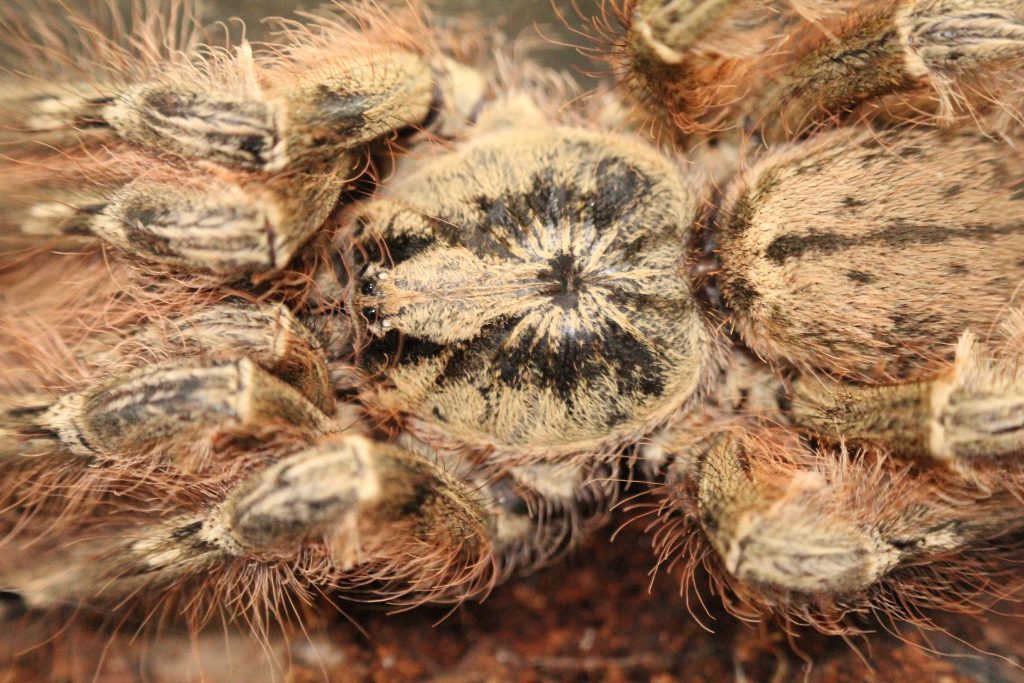Copyright 2021 Evolution Reptiles
All rights reserved.
Copyright 2025 Evolution Reptiles
All rights reserved.
All rights reserved.
This arboreal baboon species is popular among many experienced keepers. With its reputation for having a nasty bite and a temperament to match, this is a spider that should be given the utmost respect. They have the beautiful marbled pattern that is commonly associated with baboon species along with really fluffy legs, hence their common name.
This baboon species resides in lower forest regions throughout West Africa. It makes its home, using incredibly strong and versatile webbing, in the upper areas of palm trees and other suitable locations. Often they will utilize holes or gaps in order to create a tube web in which to live. As with many species of tarantula, they are rarely seen in the day and if you were to look for one in the wild your best bet would be to go out at night and look up. Temperatures in many parts of West Africa frequently exceed 30ºC during the hottest part of the day and the spiders will use their modified hides to shelter from harsher conditions. Being from the rainforest, the feather leg has evolved to live in humid environments, with the humidity sitting at up to 80% for much of the year. This does drop to a slightly lower range of 60% to 70% during the drier, ever so slightly cooler period between November and February.

Being arboreal, height is more important than width when considering an ideal enclosure for this species. A height of around 45cm is recommended for an adult. Due to the fact that this species thrives in a humid environment, either glass or acrylic enclosures tend to work most effectively. Another important element to consider is airflow and, more specifically, cross ventilation. Mold growth and other undesirable consequences will come as a result of poor ventilation in a high humidity environment, and these may affect the health of the spider. A classic example of a poorly ventilated enclosure is an aquarium or something similar, where the enclosure is deep and the only airflow comes from the upper regions. Front opening enclosures tend to offer better ventilation and, with a spider as temperamental as the feather leg, multiple access points are always useful. When heating the enclosure, it’s recommended to use a low wattage heat mat on the outside of one of the enclosure’s walls. It’s strongly advised that all heat mats are used with a thermostat, especially those that are higher than 10 watts. The temperatures within the enclosure should sit somewhere between 25ºC and 28ºC at the hottest point, with an absolute maximum of 30ºC. A moisture retaining substrate, such as coir fibre mixed with sphagnum moss or spider life works well. Aiming for a substrate depth of roughly half the body length of the spider in question is a good guideline, from our experience. When setting up the enclosure, cork tubes are your friend. These will help to perfectly replicate the environments in which you would find these animals in the wild and will allow them to create their perfect hiding place.
Keeping an S. calceatum comfortable within its environment should be reasonably straight forward. They should be sprayed once or twice per week with warm water, aiming mostly towards one half of the enclosure in order to establish a humidity gradient. It’s important to note that the smaller the spider, the quicker it will dehydrate so make sure to stay on top of the spraying routine for younger spiders. The substrate may be soaked as it begins to dry out. It is recommended to feed the spider once or twice per week with a suitable number of an appropriately sized food. This could be a couple of micro crickets or fruit flies for a sling, or perhaps an adult roach for a large female.
It’s been mentioned but it’s important to reiterate that this species is absolutely not suitable as a first spider. In fact, we wouldn’t recommend anyone take the jump to this species without some prior experience with other old world species. When working with these spiders it is always wise to anticipate the worst case scenario before it happens and prepare for that eventuality. The chances are that they will try to run when first disturbed, usually upwards. Before long, they revert to attack as the best form of defence and will bite anything they deem deserving of it. Ultimately, you want to keep your hands as far away as physically possible when working with this spider. The use of tools is recommended, as is being prepared to drop said tools quickly if the spider starts to run up them as they are known for doing. Our best advice would be to always have a catch cup to hand, as well as multiple, long tools. There hasn’t been any reliable scientific research done into the venom this species possesses, but many informal reports suggest that it is incredibly painful and could be medically significant.
See more photos on our Instagram page Evolution_Arachnids
Copyright 2021 Evolution Reptiles
All rights reserved.